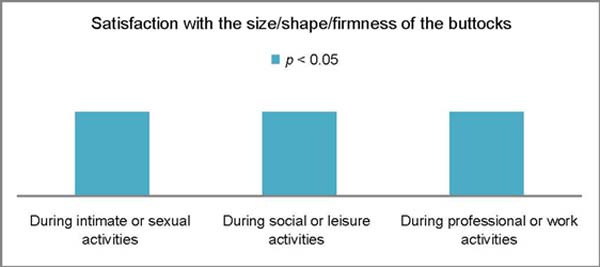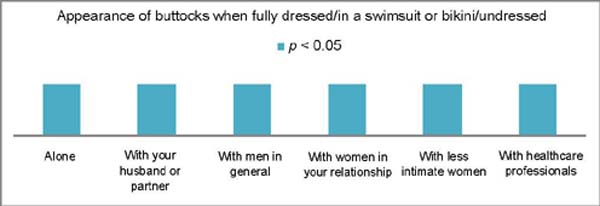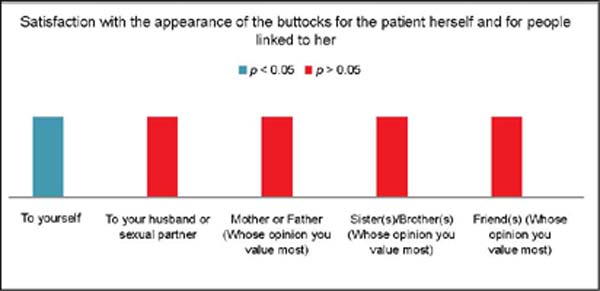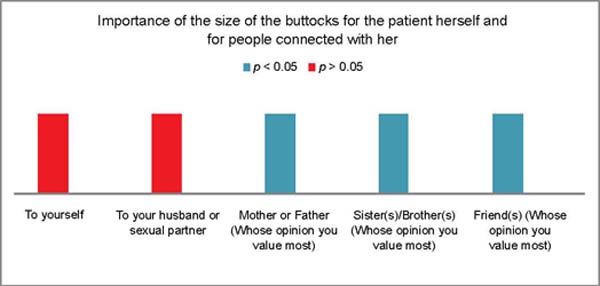

Original Article - Year 2023 - Volume 38 -
Evaluation of the degree of aesthetic satisfaction after subcutaneous gluteal fat grafting
Avaliação do grau de satisfação estético após a lipoenxertia glútea subcutânea
ABSTRACT
Introduction: Body exposure, especially in the gluteal region, has increased the demand for gluteoplasty surgery. Autologous adipose tissue has been used to correct soft tissue defects since the beginning of the last century. Its smooth, natural texture, availability in sufficient quantities, and potentially permanent integration make adipose tissue the ideal physiological filler material. In this context, gluteal fat grafting, when compared with the use of gluteal implants, offers a faster recovery period and fewer complications in the medium and long term.
Method: A prospective study was conducted using the gluteal evaluation questionnaire in patients who underwent subcutaneous gluteal fat grafting from August to December 2019. The collected data were submitted for statistical analysis by Student's t-test.
Results: Forty patients (39 females and 1 male) who underwent subcutaneous gluteal fat grafting were selected. The average age presented in the study was 36.55 years. The mean body mass index was 27.38 kg/m2. The most frequent comorbidities were varicose veins, anemia, and hypertension. In most of the hypotheses evaluated, there was a significant improvement in the quality of life of the selected patients.
Conclusion: Subcutaneous gluteal fat grafting improves patients' quality of life, which is demonstrated by the high level of satisfaction after performing this procedure.
Keywords: Reconstructive surgical procedures; Lipectomy; Allografts; Buttocks; Patient satisfaction
RESUMO
Introdução: A exposição corporal, especialmente da região glútea, tem proporcionado atualmente um aumento da procura pela cirurgia de gluteoplastia. O tecido adiposo autólogo é usado para corrigir defeitos dos tecidos moles desde o início do século passado. Sua textura suave e natural, disponível em quantidades suficientes, e sua integração potencialmente permanente são características que fazem do tecido adiposo ser o material de preenchimento fisiológico ideal. Nesse contexto, a lipoenxertia glútea, quando comparada com o uso de implantes glúteos, oferece um período de recuperação mais rápido e menos complicações a médio e longo prazo.
Método: Foi realizado um estudo prospectivo com a aplicação do questionário de avaliação dos glúteos nas pacientes submetidas a lipoenxertia glútea subcutânea no período de agosto a dezembro de 2019. Os dados coletados foram submetidos a análise estatística pelo teste t de Student.
Resultados: Foram selecionados 40 pacientes (39 do sexo feminino e 1 do sexo masculino) que foram submetidos a lipoenxertia glútea subcutânea. A média da idade apresentada no estudo foi de 36,55 anos. A média do índice de massa corporal foi de 27,38 Kg/m². As comorbidades mais frequentes foram varizes, anemia e hipertensão. Na maior parte das hipóteses avaliadas houve melhora significativa na qualidade de vida dos pacientes selecionados.
Conclusões: A lipoenxertia glútea subcutânea melhora a qualidade de vida dos pacientes, o que é demonstrado pelo alto nível de satisfação após a realização desse procedimento.
Palavras-chave: Procedimentos cirúrgicos reconstrutivos; Lipectomia; Aloenxertos; Nádegas; Satisfação do paciente
INTRODUCTION
According to the World Health Organization (WHO), “quality of life is an individual’s perception of their position in life in the context of the culture and value systems in which they live and concerning their goals, expectations, standards, and interests. “ Even when the causes of psychological discomfort are small deformities or minor, aesthetic flaws, these can cause a feeling of inferiority or a factor of emotional conflict1.
The concept of female beauty has changed over the years, but the shape and size of breasts and buttocks remain symbols of maximum femininity. Body exposure, especially in the gluteal region, has led to an increased demand for augmentation gluteoplasty surgery. This is due to better evaluation of the posterior contour and modern gluteoplasty techniques2,3.
Augmentation gluteoplasty can be performed using autologous tissues specific to the body (fat, dermal-fat flap, muscle flap) or artificial materials (implants, fillers), combined or not4.
Autologous adipose tissue has been used to correct soft tissue defects since the beginning of the last century. Its smooth and natural texture, available in sufficient quantities, and potentially permanent integration make adipose tissue the ideal physiological filling material5.
In the mid-1980s, the technique of liposuction by syringe was disseminated, which standardized methods for collecting fat simply and safely, increasing the surgeon’s interest in free fat transplantation6.
Gluteal fat grafting is an important alternative associated with the liposuction procedure, improving the aesthetic result without injecting large volumes of fat7. This technique can be applied to a wide variety of patients and avoids complications and risks intrinsic to the use of alloplastic materials, in addition to taking advantage of interactions between adipose tissue grafts and the recipient site. It offers a faster recovery period and fewer complications in the medium and long term compared to the use of gluteal implants8.
However, when the result is unexpected in plastic surgery, regrets are frequent and irrevocable1. Thus, due to the large number of plastic surgeries performed in the country, it is common that some patients are not fully satisfied with the results obtained9.
Assessment instruments in cosmetic surgery are a vital factor in assessing patient satisfaction with physical appearance. Appearance and satisfaction assessments are necessary to assess the quality of life in various surgical interventions adequately10.
OBJECTIVE
The study aims to compare the pre- and postoperative quality of life concerning the aesthetic appearance and the degree of satisfaction of patients who underwent subcutaneous gluteal fat grafting.
METHOD
The research consists of a prospective study applying the gluteal evaluation questionnaire in patients who underwent subcutaneous gluteal fat grafting from August to December 2019.
The project was approved by the Research Ethics Committee of Faculdade Evangélica Mackenzie, in Curitiba-PR, on August 9, 2019, under number CAAE 18086719.6.0000.0103.
All surgeries were performed by the same plastic surgeon in hospitals/clinics in Curitiba (PR).
The variables evaluated were age, body mass index (BMI), and comorbidities.
Inclusion criteria
Patients who underwent subcutaneous gluteal fat grafting were older than 18 and agreed to the Free and Informed Consent Form (TCLE).
Questionnaire for assessing the quality of life
The buttocks assessment questionnaire assessed the patient’s quality of life (Annex 1). This questionnaire was based on the Breast Evaluation Questionnaire (BEQ) and encompassed three aspects: satisfaction, comfort, and importance, totaling 37 questions about the appearance of the buttocks. The BEQ was originally developed in 2006 and comprised 55 questions related to satisfaction and comfort with the general appearance of the breasts.
Responses are given on a five-point scale, with 1 being very dissatisfied or very uncomfortable and 5 being very satisfied or very comfortable. The questionnaire comprises three parts. The first part questions satisfaction with the buttocks’ size, shape, and firmness in different situations: sexual, social, or professional activities. The second part verifies the degree of comfort with the appearance of the buttocks when fully dressed, in bathing suits or naked, being alone, with an intimate partner, with men in general, women in your relationship, women not so intimate, or health professionals. The third part contains two questions, the first asking them to rate their level of satisfaction with the appearance of their buttocks for themselves, their partner, parents, siblings, and friends.
The questionnaire was applied in two moments, in the pre- and postoperative consultations, with the postoperative consultation taking place between 55 and 75 days after the procedure. This time interval is necessary for the inflammatory process’s recovery and local edema reduction, allowing a more accurate assessment of patient satisfaction. The answers to the items in the questionnaire were filled out in a reserved place so as not to embarrass the exposed data.
Statistical analysis
The statistical package Statgraphics Centurion XVI and Microsoft Excel were used for the analyses. Student’s t-test was used for testing hypotheses since the calculated scores fit the normal distribution. It was verified whether the mean of the calculated scores was greater than zero, that is, whether the mean of the response scores was better in the postoperative than in the preoperative period. For the tests, a significance level of 0.05 was used.
RESULTS
Forty patients who underwent subcutaneous gluteal fat grafting were selected, 39 female and only 1 male. The age of the patients ranged from 22 to 59 years, with a mean of 36.55 years and a median of 34 years.
Of these 40 patients, the BMI ranged from 20.77 to 35.76, with a mean of 27.38. No patient was classified as having a BMI below the ideal weight, 8 (20.00%) patients had normal weight, 24 (60.00%) were overweight, 7 (17.5%) had grade I obesity, 1 (2.5%) had grade II obesity and none of the patients had grade III obesity.
Regarding the comorbidities of patients who underwent subcutaneous gluteal fat grafting in this study, 21 (52.50%) had no disease. In contrast, 4 (10.00%) patients had varicose veins, 4 (10.00%) had anemia, 4 (10.00%) were hypertensive, 2 (5.00%) patients had thyroid disease, 2 (5.00%) had some type of psychiatric disorder, 2 (5.00%) had bronchitis, 1 (2.50%) patient was with asthma, 1 (2.50%) had coagulopathy and 1 (2.50%) had liver disease. Furthermore, 3 (7.50%) patients were smokers. Among the 40 patients, 5 (12.50%) had more than one comorbidity concomitantly.
Of the 40 patients who answered the questionnaire applied in the preoperative period, only 25 (62.50%) answered the questionnaire referring to the postoperative period. Sixteen (40.00%) patients were excluded. The exclusion of 15 (37.50%) patients was due to non-response to the postoperative questionnaire. Also, 1 (2.50%) male patient was excluded to maintain the standardization of the research, totaling 24 (60.00%) patients.
The following figures represent each domain with its respective sub-items in graphs. Furthermore, the p-value obtained by statistical analysis demonstrates whether or not there was a significant improvement in the responses.
In Figure 1, referring to the domain satisfaction with the buttocks’ size/shape/firmness, an improvement was observed in all response options, demonstrated by a p-value of less than 0.05.
In Figure 2, referring to the gluteus appearance domain when fully dressed/in a bathing suit or a bikini/undressed, the p-value for all questions was also less than 0.05, indicating a significant improvement in the research result.
In Figure 3, referring to the domain satisfaction with the appearance of the buttocks, only the question “For yourself” had a significant improvement in the answers (Table 1); in the other questions, the p-value was greater than 0.05, therefore, there is no evidence to reject the null hypothesis, and the means of pre and post scores were the same.
| For yourself | Pre (%) | Post (%) | p-value |
|---|---|---|---|
| Very dissatisfied | 29.16 | 4.16 | < 0.05 |
| A little dissatisfied | 54.16 | 8.33 | |
| Neither satisfied nor dissatisfied | 4.16 | 8.33 | |
| Reasonably satisfied | 12.5 | 29.16 | |
| Very satisfied | 0 | 50 |
In Figure 4, referring to the importance domain with the size of the buttocks, there was no significant improvement in the responses in the sub-items “For yourself” and “For your husband/partner” (Table 2), as the p-value was greater than 0.05. Thus, there is no evidence to reject the null hypothesis, and the means of pre and post-scores were the same.
| For yourself | Pre (%) | Post (%) | p-value |
|---|---|---|---|
| Very dissatisfied | 0 | 4.16 | > 0.05 |
| A little dissatisfied | 16.66 | 4.16 | |
| Neither satisfied nor dissatisfied | 8.33 | 4.16 | |
| Reasonably satisfied | 25 | 16.66 | |
| Very satisfied | 50 | 70.83 |
| For your husband or sexual partner | Pre (%) | Post (%) | p-value |
|---|---|---|---|
| Very dissatisfied | 4.16 | 4.16 | > 0.05 |
| A little dissatisfied | 25 | 4.16 | |
| Neither satisfied nor dissatisfied | 16.66 | 8.33 | |
| Reasonably satisfied | 37.5 | 37.5 | |
| Very satisfied | 16.66 | 45.83 |
DISCUSSION
Plastic Surgery is a specialty where results are mainly evaluated by patient satisfaction11. Therefore, conducting studies to evaluate the quality of life and satisfaction with the aesthetic results of patients submitted to subcutaneous gluteal fat grafting is important.
Buttock augmentation, using implants or fat grafting, is among the fastest-growing procedures performed in the United States, with a 90.3% increase over the five years from 2015 to 201912.
Of the evaluated patients, the age ranged from 22 to 59 years. Compared to data from the 2019 Census of the American Society of Plastic Surgery (The Aesthetic Society), the prevalent age group of patients who underwent buttock augmentation using implants or fat grafting was between 35 and 50 years of age12. Data were consistent with this study’s mean age (36.55 years).
The average BMI presented in the study was 27.38 Kg/m², which exceeds the data obtained in the literature, whose average BMI is 24.9 Kg/m² in patients undergoing gluteoplasty with autologous fat grafting13.
In this study, we were interested in evaluating the comorbidities presented by the patients as possible interferences in the result. This was the reason why we added it to the research patient profile. As there are no data in the literature for possible comparisons, unfortunately, it was not possible to obtain results of the interference of comorbidities in the results in terms of satisfaction.
In the present study, data analysis comparing the pre and postoperative responses in the 8 domains assessed by the buttock assessment questionnaire shows a significant difference (p<0.05) in most responses. However, it was noticed that in the domain of satisfaction with the appearance of the buttocks, there was a significant improvement in the responses only for the patient herself, in contrast to people connected to her. In the domain of importance with the size of the buttocks, there was a significant improvement in the answers for mother or father, sister(s), brother (s), and friend(s,) or the one that the patient considers the most.
These findings are consistent with the study by Resende14, in which all satisfaction assessment questions and the total score improved significantly in patients undergoing surgery, except for the question that assesses the importance of breast size, in which there was no significant improvement in the patient’s responses. However, it is important to point out that these studies differ regarding the body region assessed.
Several studies demonstrate a high patient satisfaction rate after fat grafting events and good aesthetic results subjectively assessed by photographs7,13,15,16. However, some of the studies are about fat grafting in the breasts, and no prospective studies were found with instruments similar to those of this research that could serve as a reference for assessing the quality of life and satisfaction of patients during the preparation period.
Due to the limited sample size and the lack of studies with instruments that could serve for possible comparisons, it would be interesting to replicate the essence of the present study in future research to confirm the results.
CONCLUSION
With the results obtained, it is possible to conclude that subcutaneous gluteal fat grafting improved the quality of life of the evaluated patients, showing a high level of satisfaction in several aspects of their social life after performing this procedure.
REFERENCES
1. Tournieux TT, Aguiar LFS, Almeida MWR, Prado LFAM, Radwanski HN, Pitanguy I. Estudo prospectivo da avaliação da qualidade de vida e aspectos psicossociais em cirurgia plástica estética. Rev Bras Cir Plást. 2009;24(3):357-61.
2. Mendieta CG. Classification System for Gluteal Evaluation. Clin Plast Surg. 2006;33(3):333-46.
3. Almeida Júnior GL, Castro WC, Almeida EG. Implante glúteo em posição intramuscular parcial: relato de caso. Rev Bras Cir Plást. 2009;24(2):242-5.
4. Azevedo DM, Gonçalves Junior P, Pereira J, Amoedo TB, Kuroyanagi FM, Cotes EFM, et al. Gluteoplastia de aumento: experiência do Serviço de Cirurgia Plástica Dr. Ewaldo Bolivar de Souza Pinto. Rev Bras Cir Plást. 2012;27(1):87-92.
5. Bezerra FJF, Moura RMG, Maia Neto JD. Lipoenxertia em reconstrução mamária. Rev Bras Cir Plást. 2013;28(2):241-6.
6. Toledo LS, Mauad R. Fat injection: A 20-year revision. Clin Plast Surg. 2006;33(1):47-53.
7. Silveira GD, Cioffi MAB, Aita CD, Floriani JHG, Oliveira M P, Jaeger MRO. Double bubble em gluteoplastias com implantes no contorno corporal feminino: como prevenir e tratar. Rev Bras Cir Plást. 2018;33(Suppl.1):23-5.
8. Vallarta-Rodríguez RA, Ruiz-Treviño JJ, Guerrero-Burgos F. Gluteoplastia tridimensional mediante distribución volumétrica precisa. Cir Plast Ibero- Latinoam. 2016;42(4):321-9.
9. Rodrigues LG, Madureira EMP. Perfil e satisfação das acadêmicas de medicina de uma faculdade particular de cascavel/PR em relação às cirurgias plásticas submetidas. Rev Thêma Sci. 2014;4(1):65-74.
10. Anderson RC, Cunningham B, Tafesse E, Lenderking WR. Validation of the breast evaluation questionnaire for use with breast surgery patients. Plast Reconstr Surg. 2006;118(3):597-602.
11. Chen CM, Cano SJ, Klassen A F, King T, McCarthy C, Cordeiro PG, et al. Measuring quality of life in oncologic breast surgery: a systematic review of patient-reported outcome measures. Breast J. 2010;16(6):587-97.
12. The Aesthetic Society. Aesthetic Plastic Surgery National Databank Statistics. Garden Grove: The Aesthetic Society; 2019. 24 p. Disponível em: https://cdn.theaestheticsociety.org/media/statistics/2019-TheAestheticSocietyStatistics.pdf
13. Rosique RG. Gluteoplastia com lipoenxertia autóloga: experiência pessoal. Bol Cir Plást. 2015;170:1.
14. Resende VCL. Satisfação, atividade física e sexualidade em pacientes submetidas à mamoplastia redutora [Dissertação]. São Paulo: Universidade Federal de São Paulo; 2013.
15. Losken A, Pinell XA, Sikoro K, Yezhelyev M V, Anderson E, Carlson G W. Autologous fat grafting in secondary breast reconstruction. Ann Plast Surg. 2011;66(5):518-22.
16. Del Vecchio DA, Bucky L P. Breast augmentation using preexpansion and autologous fat transplantation: a clinical radiographic study. Plast Reconstr Surg. 2011;127(6):2441-50.
Buttock Assessment Questionnaire.
BUTTOCK ASSESSMENT QUESTIONNAIRE
To the patient: Write down the number most suitable for your answer. Use only one alternative per answer. Please answer all questions. Do not leave any items blank.
1. How satisfied are you with each of the following items?
Please rate the questions by filling in the number according to the scale below:
1 = Very Dissatisfied
2 = A little dissatisfied
3 = Neither Satisfied Nor Dissatisfied
4 = Fairly Satisfied
5 = Very Satisfied
With the size of your glutes?
During intimate or sexual activities _____
During social or leisure activities _____
During professional activities or work _____
With the shape of your glutes?
During intimate or sexual activities _____
During social or leisure activities _____
During professional activities or work _____
With the firmness of your glutes?
During intimate or sexual activities _____
During social or leisure activities _____
During professional activities or work _____
2. How do you feel about the comfort or discomfort in each of the following items, being alone, with your boyfriend or intimate partner, with other women in your relationship (family or friends), with men in general, with less intimate women (gym or locker room) or with health professionals (doctors or nurses)?
Please rate the questions by filling in the number according to the scale below:
1 = Very Uncomfortable
2 = A Little Uncomfortable
3 = Neither Comfortable Nor Uncomfortable
4 = Fairly Comfortable
5 = Very Comfortable
How about what your glutes look like when you’re fully dressed?
Alone _____
With your husband or partner _____
With men in general _____
With women in your relationship _____
With less intimate women _____
With healthcare professionals _____
How about what your buttocks look like when you’re in a bathing suit or bikini?
Alone _____
With your husband or partner _____
With men in general _____
With women in your relationship _____
With less intimate women _____
With healthcare professionals _____
As for what your buttocks look like when you’re undressed (unclothed)?
Alone _____
With your husband or partner _____
With men in general _____
With women in your relationship _____
With less intimate women _____
With healthcare professionals _____
3. Are you and those close to you satisfied with the (visual) appearance of your glutes?
Please rate the questions by filling in the number as per the scale below:
1 = Very Dissatisfied
2 = A little dissatisfied
3 = Neither Satisfied Nor Dissatisfied
4 = Fairly Satisfied
5 = Very Satisfied
To yourself _____
To your husband or sexual partner _____
Mother or Father (Whose opinion you value most) _____
Sister(s)/Brother(s) (Whose opinion you value most) _____
Friend(s) (Whose opinion you value most) _____
4. Do you and your people care about the size of your glutes (do you notice)?
Please rate the questions by filling in the number according to the scale below:
1 = Totally Unimportant
2 = Little Important
3 = Neither Important nor Unimportant
4 = Fairly Important
5 = Very Important
To yourself _____
To your husband or sexual partner _____
Mother or Father (Whose opinion you value most) _____
Sister(s)/Brother(s) (Whose opinion you value most) _____
Friend(s) (Whose opinion you value most) _____
1. Clínica Matioski, Curitiba, PR, Brazil
2. Faculdade Evangélica Mackenzie do Paraná, Curitiba, PR, Brazil
Corresponding author: Gabriel Paiva Kroneis Rua Jerônimo Durski 1533, Curitiba, PR, Brazil. Zip Code: 80730-290. E-mail: paivagabriel.gp@gmail.com
Article received: December 16, 2021.
Article accepted: September 13, 2022.
Conflicts of interest: none.













 Read in Portuguese
Read in Portuguese
 Read in English
Read in English
 PDF PT
PDF PT
 Print
Print
 Send this article by email
Send this article by email
 How to Cite
How to Cite
 Mendeley
Mendeley
 Pocket
Pocket
 Twitter
Twitter